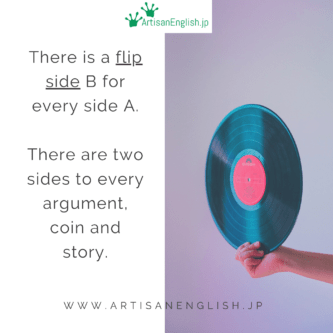
YouTube / iTunes / Spotify / Radio Public / Pocket Casts / Google Podcasts / Breaker / Overcast
Listen to ArtisanEnglish.jp posts & lesson intros here.
Word of the Day: Flip side
Whether you want to admit it or not, Newton was correct in more ways than one when he said, “For every action, there is an equal and opposite reaction.”
We can extend his statement of truth and say that there is a flip side B for every side A, and for every positive side to an argument, there is a negative flip side.
The flip side is the B-side of a record or cassette tape.
It’s also the other side of an argument, debate or story.
There are two sides to every coin, argument and story.
Most often, the flip side is not the best.
If you remember records or cassette tapes, then you know that the B-sides often contained the songs that were not the best.
The best ones were on the A-side, so you could listen to them first.
Now that I’ve mentioned records, this is an excellent opportunity to say that the term flip side probably came from records in that it was the side you listened to after you flipped the record over.
Cassette tapes were more annoying because if you wanted to re-listen to the A-side, you had to rewind it first.
Remember doing that with a pencil or your pinky finger?
Sorry, there’s not much time for waxing nostalgic today.
Our topic is not the way we listened to music when we were younger.
Before I started ArtisanEnglish.jp, I remember doing online debates with students at another online English school.
First, I would let the students choose the side they wanted to argue for, and then I would make them argue the flip side.
At first, they were quite shocked.
They had never argued the flip side of an argument before.
You see if you can argue both sides of an argument, you are better able to win because you can predict what the other person will say before they say it and counter it.
Flesch-Kincaid Readability Test
This post is understandable by someone with at least a 7th-grade education (age 12).
On the Flesch-Kincaid reading-ease test, this post scores 73.
The easier a passage is to read, the higher the score on a scale of 0 – 100.

